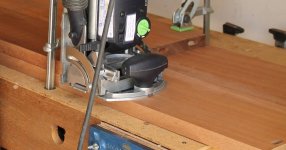Bugsysiegals said:grbmds said:If it were me, I'd just keep returning then until you get one that performs to your satisfaction. The Domino is a great tool but only if it performs as it is supposed to. I guess I feel lucky I have never had the problems with Festool or the places I've bought the tools from that you are experiencing. Maybe it just is a sign that Festool's quality control has slipped over the years. I haven't bought one for at least 2 years so I can't tell about present quality. Good luck.
Do your paddles actually align better than mine and do you use the paddles? I assumed they'd be useful for quick corner joints on shorter lengths since you can avoid laying out lines but in reality maybe their seldom used?
The only time I use the paddles is if I want Dominos the same distance from each edge of a board. If I’m putting more than 2 Dominos then I usually mark the internal slots and may use the paddles for the two outermost slots. I’m unsure how you are using them but, if it’s to locate a slot on both boards the same distance from an edge on each, I don’t understand how that could be misaligned. I do find that I mostly just put the boards together, mark the locations on both, and cut the slots. As for side to side alignment I many times cut 1 slot with the small width and the others with the mid-size slot to allow some adjustment. However, I have cut all the slots the same size and usually get great results. Don’t know if that helps.


